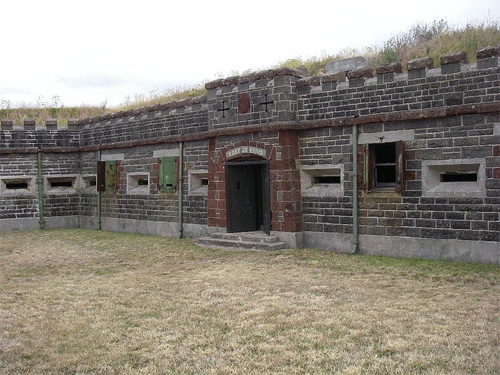
Fort Jervois (1895), Lyttelton Harbour
Xenophobia’s ramparts on the sea?
New Zealanders thrilled to their first ‘Russian Scare’ more than a century before the collapse of the Soviet Union. In 1873 the Daily Southern Cross ran a hoax story about a Russian cruiser bombarding Auckland. For most of that time we relied on the Royal Navy, but from the 1880s to 1957 we also maintained coastal defence batteries.
Ngāi Tahu had last used Rīpapa (‘mooring rock’) as a refuge pā in the late 1820s. Identified as a potential battery site in 1857, Rīpapa became a quarantine station for Vogel’s immigrants in 1873. They called it Humanity Island, a name Taranaki Māori held prisoner here in 1880 may have found ironic.
In the mid-1880s tension between the British and Russian empires drove New Zealand to fortify its main ports. Rīpapa formed part of Lyttelton’s defences, along with Battery, Spur and Erskine Points. Down came the quarantine buildings and the top 5 m of the island itself. Workers completed a submarine mining depot in 1886 but funding cuts slowed other work, forcing the use of prison labour, the ‘Devil's Own Brigade’. Although the big guns, two 8-inch rifled muzzle-loaders and two 6-inch hydro-pneumatic disappearing guns, were in place by 1889, construction work dragged on until 1895 and finishing work took even longer. At Fort Jervois, as it was named after former Governor Sir William Jervois, an imperial expert on coastal defences, crenellations and mock crossed-arrow slits gave a theatrical look to the colony’s most complete single fortress. Experts complained that the guns were bunched too closely together.
Fort Jervois never fired a shot in anger. For a while it was a detention centre for the ‘Ripapa Island martyrs’, young conscientious objectors who staged a hunger strike here in 1913. During the First World War it was battery HQ for Lyttelton and the examination battery, and it also briefly held Lieutenant Commander Graf Felix von Luckner, a noted German navy raider. It was downgraded from fort to magazine in 1922 and abandoned three years later. The army reinstated it as a magazine in 1936 and in 1941 returned one 55-year-old gun to marginal operational status. In 1943, however, the weapon was declared ineffective and three years later the army left the fort to the harbour board and then the Navy League’s sea cadets.
1990 was an important year for Rīpapa Island. It became an historic reserve and the Institution of Professional Engineers of New Zealand awarded it a commemorative plaque. DOC now administers the island which, thanks to the sea cadets, is remarkably well preserved. Until the 2010-11 earthquakes you could see the 1886 Whitehead torpedo store, the mine store, the fortifications and two of the guns. The island is currently closed for repairs.
Further information
This site is item number 70 on the History of New Zealand in 100 Places list.
Websites
Books
- Peter Cooke, Defending New Zealand, Defence of New Zealand Study Group, Wellington, 2000
- Ian McGibbon, The path to Gallipoli, GP Books, Wellington, 1991



Community contributions